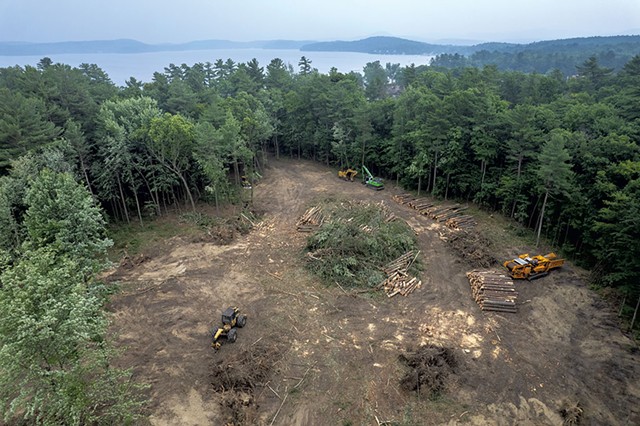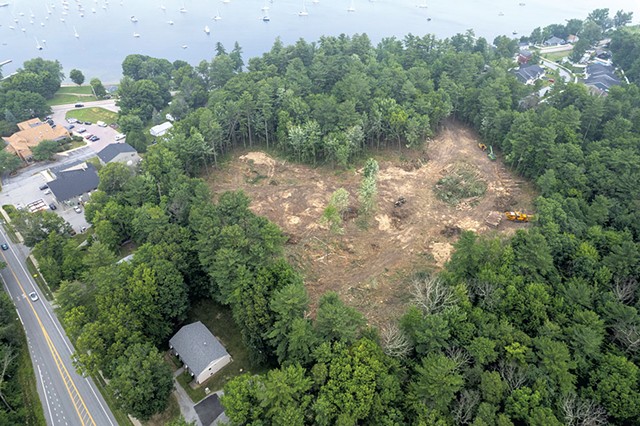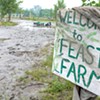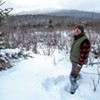Switch to the mobile version of this page.
Vermont's Independent Voice
- News
- Arts+Culture
- Home+Design
- Food
- Cannabis
- Music
- On Screen
- Events
- Jobs
- Obituaries
- Classifieds
- Personals
Browse News
Departments
-
Education

Scott Official Pushes Back on Former State…
-
News

Burlington Budget Deficit Balloons to $13.1 Million
-
Education

Senate Committee Votes 3-2 to Recommend Saunders…
- Court Rejects Roxbury's Request to Block School Budget Vote Education 0
- Norwich University Names New President Education 0
- Media Note: Mitch Wertlieb Named Host of 'Vermont This Week' Health Care 0
Browse Arts + Culture
View All
local resources
Browse Food + Drink
View All
Browse Cannabis
View All
-
Culture

'Cannasations' Podcaster Kris Brown Aims to 'Humanize'…
-
True 802

A Burlington Cannabis Shop Plans to Host…
-
Business

Judge Tosses Burlington Cannabiz Owner's Lawsuit
-
Health + Fitness

Vermont's Cannabis Nurse Hotline Answers Health Questions…
-
Business

Waterbury Couple Buy Rare Vermont Cannabis License
Browse Music
View All
Browse On Screen
Browse Events
Browse Classifieds
Browse Personals
-

If you're looking for "I Spys," dating or LTRs, this is your scene.
View Profiles
Special Reports
Pubs+More
Ecologists, Neighbors Protest Colchester Rec Center Construction
Published July 5, 2023 at 10:00 a.m. | Updated July 5, 2023 at 12:01 p.m.
Hemmed in by a pair of busy roads, homes and a cluster of commercial buildings, a 14-acre forest in Colchester is not the type of natural area that typically draws the interest of ecologists.
But scientists have joined forces with local residents in an effort to stop the town from building a recreation center on the tract it owns between Lakeshore Drive and Blakely Road. Three days after heavy machinery started felling trees on June 23, two dozen people asked the District #4 Environmental Commission to require an Act 250 land-use permit for the project.
A different group, including some of those whose names were included in the letter to the district commission, appealed the project's Development Review Board permit to the Environmental Division of Superior Court.
The advocates' reasons are varied, but their mission is the same: to convince the state's land-use regulators that the town hasn't described the full scope of the work that is going to take place in the area. The town said the development will only cover 4.6 acres of the 14-acre forest. Opponents responded that a planned sewer project and some intersection improvements nearby are related to the recreation center and that including them would bump the size of the project up to more than 10 acres — triggering scrutiny under Act 250, Vermont's land-use law.
"There are ample facts to demonstrate that Colchester deliberately skirted Act 250 jurisdiction," resident Jack Scully said.
Town Manager Aaron Frank said the district environmental commission has already concluded that Colchester doesn't need an Act 250 permit for the project, which has been in the works since 2001. Frank added that residents have had plenty of opportunities to speak out at public meetings. The site, across the road from the high school, aligns with the goal of promoting dense development.
"This area is very central; there are bike paths that lead to it," Frank said. "It's not out in the middle of a green field somewhere where there is nothing else developed."
That's not the point, many of the project's opponents say. No matter its location, the site includes a threatened woodland community that deserves protection. The remnant of sand plain forest is a rare ecosystem that was created along the shores of Lake Champlain as glaciers melted 10,000 to 15,000 years ago, depositing dozens of feet of sand. Oak and pine trees dominate, with an underbrush of heath shrubs.
Ecologist Brett Engstrom, who assesses natural communities as a consultant for public and private clients, first studied this forest type in 1990 as part of an inventory of Chittenden County's natural areas for the Nongame and Natural Heritage Program.
Engstrom determined that Vermont once had 15,000 acres of sand plain forests, home to pitch pine, red maple and black oak trees and an array of rare plants such as harsh sunflower and squarrose goldenrod. The flat, sandy plains are convenient to build on, and the ones on the eastern shores of Lake Champlain are now mostly covered in homes, lawns and commercial buildings.
Engstrom got involved in the recreation center controversy when Colchester resident Lori Barg, a hydrogeologist, informed him that residents had voted at town meeting to build on the rare parcel. The town of 18,000 residents plans a $16 million building with a gymnasium, elevated track, weight room and meeting spaces.
Barg and Engstrom said the town has other land available for the recreation center, and the 14 acres, known as the Bayside-Hazelett property, should remain untouched. Of the original 15,000 acres of sand plain forest around Lake Champlain, only about 500 acres remain relatively undeveloped, Engstrom said.
"It's been whittled down," Engstrom said. "Believe it or not, that 14-acre remnant is one of the best examples we have left of that natural community. And it's tiny."
Scott Wood, who lives on the edge of the parcel, asked Stowe environmental lawyer Brice Simon to request a full Act 250 review. Simon said other supporters asked to have their names added to his letter in late June, as the town started cutting down trees.
"The full and future extent of this project is not fully described in recent presentations by the town of Colchester," the letter says.
Eleven of the people whose names are included in Simon's letter are Colchester residents, including Barg; another 11 are ecologists in other parts of the state who want the natural area to be saved, Simon said.
Frank said the matter was settled when the district commission told the town in April that no Act 250 review was needed. "The jurisdictional opinion, in my understanding, is a permit," he said, noting that opponents could have filed an appeal before the deadline in May. "I'm a little confused by this latest effort."
He said on Monday that he hadn't heard from Kaitlin Hayes, the District #4 coordinator, about the latest request to reconsider the jurisdiction question. Hayes did not respond to messages left last week.
Wood said he thinks the town is trying to avoid Act 250 scrutiny because if all the facts were known, the permit would be denied. He said Glen Cuttitta, the town's parks and recreation director, brought up Act 250 during a 2019 Recreation Advisory Board meeting.
"There are 14 acres in the area, however; Mr. Cuttitta stated that [the town] will set aside 4 acres to avoid having to go through Act 250 (we would have to if it was over 10 acres)," the minutes say.
Project opponents hope raising awareness will help their cause.
"Other than public outcry/democratic change (voting out the officials who support the project) Act 250 is probably the only means of drawing more attention to the impacts on the sandplain forest," Simon wrote in an email.
To that end, opponents purchased 400 Dum Dums lollipops to attach to a pamphlet ("for this very dumb idea," Barg said in an email) to be passed out at the town's Fourth of July parade. Barg is also hoping volunteers can lead tours to the site "to see the corpse," referring to the scene of forest destruction.
"It's heartbreaking," she said. "It's so stupid for a 19,000-square-foot building to destroy 250,000 square feet of forest."
On June 30, Barg helped Jeff Conley, who owns a four-unit apartment building next to the site, measure the distance between his property line and the tree cutting. Conley said he hadn't expected the recreation center plan to be approved at town meeting because of the expense, but he's not opposed to it. In fact, he thinks it's an asset to the community. He just wants to make sure that the cutting doesn't affect the trees that stand between his apartment building and the recreation center site.
click to enlarge 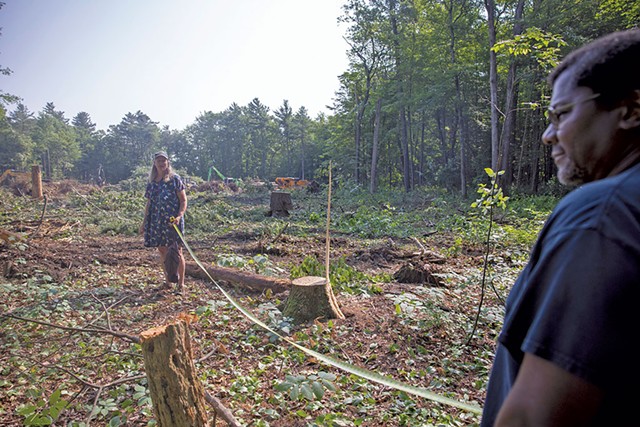

- James Buck
- Lori Barg (left) and Jeff Conley measuring the distance from Conley's property line to the tree cutting
"This kind of surprised me," Conley said as he stood at the edge of the forest, gazing at newly cut stumps.
Barg is opposed to the destruction of the rare habitat, and she's also against the recreation center on policy grounds. An annual family membership would cost $1,200, she said, putting it out of reach for many.
"It's public money for a private club for rich people," she said. Frank and his deputy, Renae Marshall, disputed that, saying the center would be the site of many free town recreational programs that have outgrown their donated spaces in school buildings.
Colchester bought the property in 2004 for $1.1 million for a recreation center. The town raised nearly $9 million for the construction from a local option tax that was passed in 2015 and the rest from a $6.9 million bond that voters approved at town meeting in March.
Wood, the resident who sought Act 250 review in June, agrees with Barg about the center, which he described as a "pay to play, government-run gym.
"The area already has enough gyms that will now have town-funded competition," he said by email.
Scully said he sees the center as "reckless overspending of our local option tax money" and said he hoped residents would attend the next selectboard meeting, on July 11, to make their voices heard.
For Engstrom, though, the matter begins and ends with the fate of the forest. And while the presence of this ecosystem is not well known in Chittenden County, it does have other defenders. The Lake Champlain Land Trust is restoring a 35-acre parcel, also in Colchester, by removing large oak and white pine trees to make more room for pitch pines to grow. And in 2021, the state Agency of Natural Resources started restoring a sand plain forest in Milton.
Engstrom said mature forests of all types are exceptionally good at carbon sequestration, and they cool the air through shade and evaporation. The rare plants they shelter have an intrinsic value because losing any species, he said, has a ripple effect that is sometimes not apparent until later.
"Losing species due to habitat fragmentation, invasives, insecticides — you name it — can have deleterious effects on human lives," he said. "We need other species."
Correction, July 7, 2023: A previous version of this story referred to the western shore of Lake Champlain when it should have read the eastern shore. The story has been updated.The original print version of this article was headlined "Not in My Forest | Ecologists, neighbors protest Colchester rec center construction"
Related Stories
Got something to say?
Send a letter to the editor
and we'll publish your feedback in print!
Tags: Environment, Colchester, Act 250, recreation center
More By This Author
About The Author

Anne Wallace Allen
Bio:
Anne Wallace Allen covers breaking news and business stories for Seven Days. She was the editor at the Idaho Business Review and a reporter for VTDigger and the Associated Press in Montpelier.
Anne Wallace Allen covers breaking news and business stories for Seven Days. She was the editor at the Idaho Business Review and a reporter for VTDigger and the Associated Press in Montpelier.
About the Artist

James Buck
Bio:
James Buck is a multimedia journalist for Seven Days.
James Buck is a multimedia journalist for Seven Days.
Speaking of...
-

Totally Transfixed: A Rare Eclipse on a Bluebird Day Dazzled Crowds in Northern Vermont
Apr 10, 2024 -

Dick Mazza Steps Down From Vermont Senate
Apr 8, 2024 -

Thingz From Yaad Brings Jamaican Cuisine to a Former Dining Hall in Colchester
Apr 2, 2024 -

Vermont Lawmakers May Have to Meet Growing Problems With a Shrinking Budget in 2024
Dec 20, 2023 -

Colchester’s Guilty Plate Diner to Close; Relocated Heart n Soul to Open in South Burlington
Nov 21, 2023 - More »
Comments
Comments are closed.
From 2014-2020, Seven Days allowed readers to comment on all stories posted on our website. While we've appreciated the suggestions and insights, right now Seven Days is prioritizing our core mission — producing high-quality, responsible local journalism — over moderating online debates between readers.
To criticize, correct or praise our reporting, please send us a letter to the editor or send us a tip. We’ll check it out and report the results.
Online comments may return when we have better tech tools for managing them. Thanks for reading.
- 1. Burlington Budget Deficit Balloons to $13.1 Million News
- 2. Legislature Advances Measures to Improve Vermont’s Response to Animal Cruelty Politics
- 3. Vermont Rep. Emilie Kornheiser Sees Raising Revenue as Part of Her Mission Politics
- 4. Senate Committee Votes 3-2 to Recommend Saunders as Education Secretary Education
- 5. Scott Official Pushes Back on Former State Board of Ed Chair's Testimony Education
- 6. Norwich University Names New President Education
- 7. Barre to Sell Two Parking Lots for $1 to Housing Developer Housing Crisis
- 1. Totally Transfixed: A Rare Eclipse on a Bluebird Day Dazzled Crowds in Northern Vermont 2024 Solar Eclipse
- 2. Zoie Saunders, Gov. Scott’s Pick for Education Secretary, Faces Questions About Her Qualifications Education
- 3. Don't Trash Those Solar Eclipse Glasses! Groups Collect Them to Be Reused 2024 Solar Eclipse
- 4. State Will Build Secure Juvenile Treatment Center in Vergennes News
- 5. Vermont Awarded $62 Million in Federal Solar Incentives News
- 6. Rising Costs and Property Tax Hikes Again Threaten the Survival of Small Schools Education
- 7. Queen of the City: Mulvaney-Stanak Sworn In as Burlington Mayor News


























